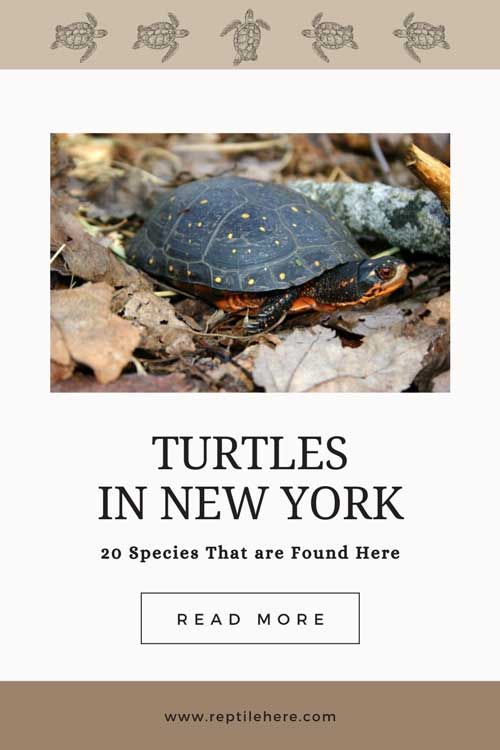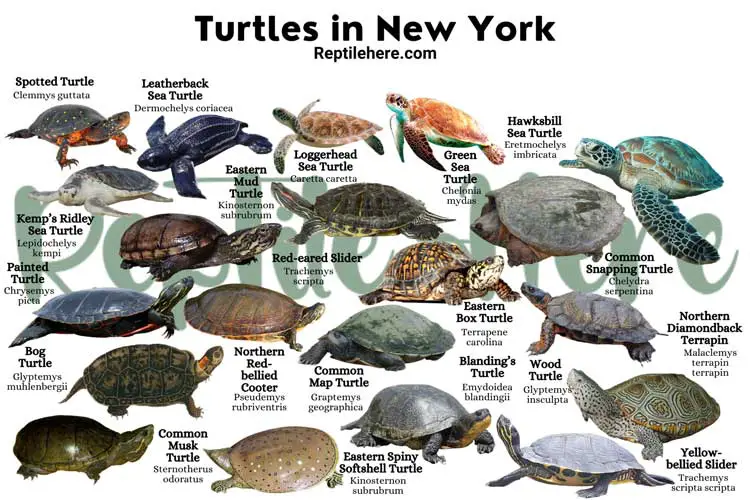Turtles in New York – 20 Species That are Found Here
New York is home to 20 species of turtles. Only 12 of them are native to the Empire State and range from the aquatic common snapping turtles (the NY official state reptile), to the semi-aquatic Bog and Spotted turtles, to the terrestrial eastern box turtles.
The state is also home to some non-native turtle species that mainly result from the pet trade or pet releases by unprepared pet owners. These include the northern red-bellied Cooter, Northern diamondback terrapin, red-eared slider, and yellow-bellied sliders.
On top of all this, 5 sea turtle species have been spotted in the state of New York. These include the Green Sea, Leatherback, Hawksbill, Loggerhead, and Kemp Ridley sea turtles.
The following article takes you through the complete list of turtle species that inhabit New York. We have shared key details and key facts about each turtle like the looks, average adult size, diet, habitat, lifespan, and conservation status.
20 Types Of Turtles in New York
Contents
1. Common Snapping Turtle
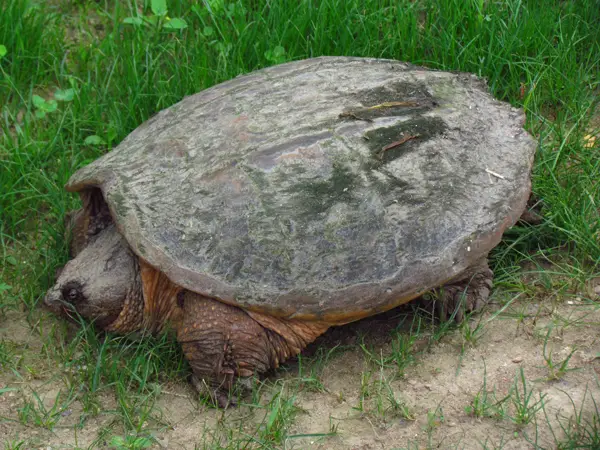
- Scientific name: Chelydra serpentina
- Common name: Snapping Turtle
- Family: Chelydridae
- Size: 8 to 18 1/2 inches
- Lifespan: 30 to 50 years or more
- Conservation status: Least Concern
The common snapping turtle is one of the most popular turtle species across the US states and is also found within the borders of New York. it is pretty widespread across NY and boasts its position as the official reptile of the state.
Common snapping turtles in New York are unprotected and can be legally owned as pets.
An average common snapping adult turtle is pretty large and has a shell length of 18½ inches long. It is easily recognizable for this large size plus an intimidating appearance!
This species has a chunky head, a long tail, strong claws, and large webbed feet. The shell color is black or olive and has no distinct pattern. These New York snapping turtles are also known for their hook-like powerful jaws—they’re so strong that these turtles eat other turtles!
You’ll find them in waterbodies with muddy bottoms. Examples include marshes, ponds, lakes, rivers, and even shallow streams. They generally prefer waters with aquatic vegetation in plenty and foods such as fish, frogs, birds, etc.
These New York turtles generally show docile behavior but can get quite aggressive if taken out of water. The best way to calm it is to take it back to the waters, where it feels safe.
2. Eastern Spiny Softshell Turtle
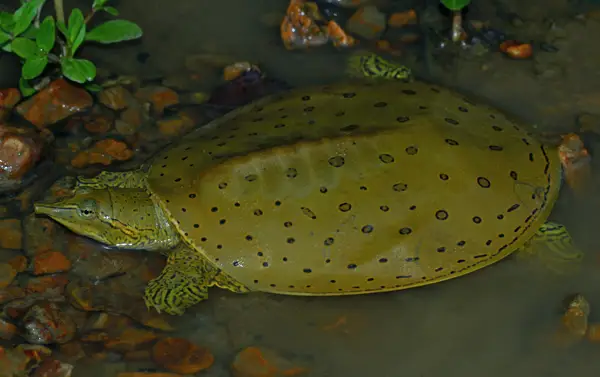
- Scientific name: Apalone spinifera Spinifera
- Common name: Spiny Softshell Turtle
- Family: Trionychidae
- Size: 5 to 9 inches (males), 12 to 20 inches (females)
- Lifespan: 30 to 70 years
- Conservation status: Least Concern
The Eastern Spiny softshell turtle is a medium-to-large freshwater species that live in the western counties of New York. It prefers lakes, streams, and rivers with muddy or sandy bottoms and little or no vegetation.
Female spiny softshell turtles are usually larger than males. And unlike other turtles, this species has a flexible, leather-like carapace that’s extremely rounded and flattened. The shell color can be olive grey or yellow-brown.
Also, the shell usually features dark spots and a row of small spines running toward the shell’s front edge.
Just like other softshell turtles, this species also has a long, tapered snout which helps it easily breathe when buried in the sand.
The young ones feature well-defined round spots that are easily visible on the shell (though these spots become invisible as they transition to adulthood).
Spiny softshell turtles of New York are mainly carnivorous and like eating anything they find in the waters including crayfish, insects, small fish, and so on. They hunt by burying themselves in the mud or sand while keeping their head uncovered to grab food as it swims by.
These turtles are also able to breathe underwater by taking in oxygen through their throat skin. This is a useful adaptation given that they don’t spend a lot of time out of water.
Other adaptations of these turtles include webbed feed, long claws, and extremely flat shells that enable them to quickly swim away from predators and burry in the muddy bottom of the waters they reside in.
3. Painted Turtle (Eastern and Midland subspecies)
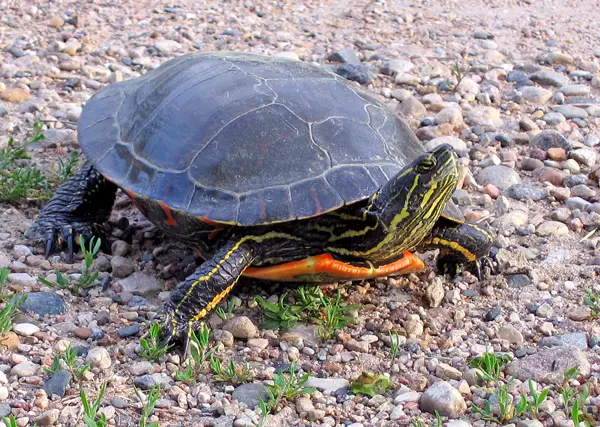
- Scientific name: Chrysemys picta
- Common name: Painted Turtle
- Family: Emydidae
- Size: 4 to 6 inches
- Lifespan: 30 to 50 years
- Conservation status: Least Concern
New York is home to two painted turtle subspecies—namely the Eastern Painted Turtle (Chrysemys picta picta) and Midland Painted turtle (Chrysemys picta marginata).
The eastern painted turtle is more dominant in the southeastern and central areas of New York. And the midland species is more common in central, western, and northern counties.
It is difficult to tell apart the two species. However, the eastern painted turtle has scutes running in line of straight rows with pale front edges, unlike other painted turtle species. The Midland species is defined by dark, shadow-like patches at the center of its plastron.
The two painted turtle species in New York tend to live near water bodies with minimal movements. Examples include marshes, ponds, slow-moving streams with sandy/muddy bottoms, small lakes, etc.
They also prefer areas with aquatic plants in plenty as they make their primary food source in the wild.
Note that these painted turtles of New York are often seen basking on stumps and logs beside the waters. Both subspecies are omnivores; the eastern painted turtle is more into small fish and plants while the midland subspecies mainly feed on insects and vegetation.
4. Northern Diamondback Terrapin

- Scientific name: Malaclemys terrapin terrapin
- Common name: Diamond-backed Terrapin
- Family: Emydidae
- Size: 4 to 6 inches (males), 5 to 8 inches (females)
- Lifespan: 25 to 40 years
- Conservation status: Vulnerable
The Diamondback terrapin is the only freshwater species in New York that can adapt to saltwater habitats as well. Their shells have a raised diamond shape, hence the name diamondback. The term “terrapin” simply means little turtle.
A typical diamondback terrapin in New York has a black or brown carapace and yellow lower shell that may sometimes feature dark-colored patterns. The turtle’s skin is usually grey-white with multiple small black spots.
Female diamondback terrapins are usually bigger than their male counterparts.
These turtles are highly timid and can easily get stressed when in captivity. They’re pretty docile and can be handled. However, they’re known to bite as a way of defending themselves if they feel threatened.
Diamondback terrapins in New York can be found along the coast in tidal flats, salt marshes, barrier beaches, and brackish streams in New York. They can also stay in full-strength saltwater for longer periods.
These terrapins are largely carnivorous and feed on crustaceans, fish, crabs, shrimps, marine snails, marine worms, mollusks, mussels, clams, and barnacles. However, they also tend to occasionally ingest small amounts of plant matter.
5. Northern Red-bellied Cooter
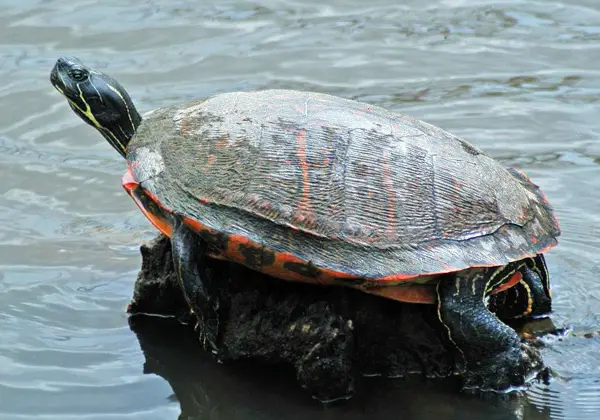
- Scientific name: Pseudemys rubriventris
- Common name: Northern Red-Bellied Turtle,American red-bellied turtle
- Family: Emydidae
- Size: 10 to 12 inches
- Lifespan: 40 to 60 years
- Conservation status: Not Threatened
The Northern red-bellied Cooters are the largest of North America’s pond turtles and non-native to New York. They’ve been sighted in New York City areas as well as in the state’s central counties.
As you can tell from its name, this species features a completely red (vibrant) plastron, sometimes covered with green spots. The turtle is known to live in freshwater streams, ponds, and lakes in New York.
And when the conditions allow, the turtle will venture into brackish streams near the New York coast.
A redbelly Cooter differs from other turtles with its head pattern which has lighter markings forming a distinct arrow shape, pointing toward the snout. The upper shell ranges form from dark brown to black.
Since the Northern redbelly turtles of New York are mainly herbivorous, they mostly feed on aquatic plants.
Note that this turtle species in New York face many threats including wetland loss, habitat loss, pollution, and collection for selling as pets.
At some point, this turtle was even sold for consumption (some countries still consume it even today!)
6. Common Map Turtle
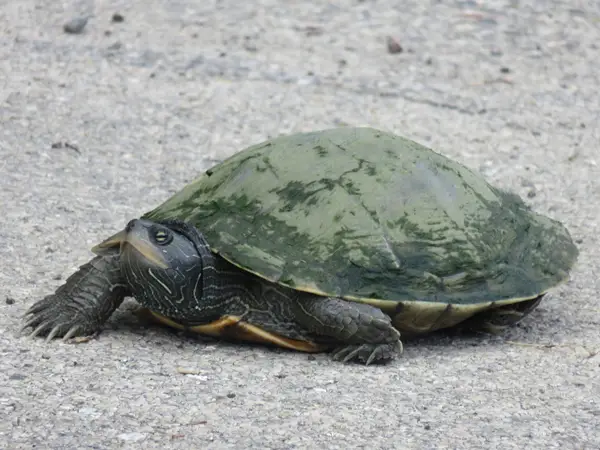
- Scientific name: Graptemys geographica
- Common name: Common Map Turtle, Northern Map Turtle
- Family: Emydidae
- Size: 3 to 10 inches
- Lifespan: 30 to 50 years
- Conservation status: Least Concern
The Common map turtle has also been observed in New York. To be more specie, this freshwater turtle resides in the New York major river systems, including Hudson.
They prefer living in large waterbodies with debris. These offer the perfect spots for basking while the water bodies enable them to spend their hibernation periods in winter completely submerged.
Like other map turtles, this common map turtle gets its name from the map-like pattern on its shell. Its shell is typically darker and ranges from brown to black. The map pattern has a lighter coloration.
The common map turtle of New York is mainly carnivorous and feeds on mollusks such as clams and snails. It will also eat crayfish and insects. And when animal matter gets scarce, it will feed on plant matter.
Note that it may be difficult to spot a common map turtle in the wild in New York. Although active during the day, these turtles are quite timid and will quickly retreat to the waters at the slightest disturbance.
7. Eastern Mud Turtle
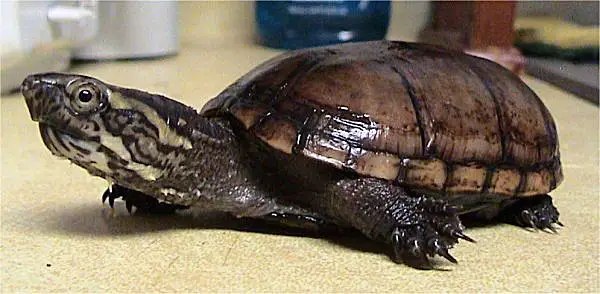
- Scientific name: Kinosternon subrubrum
- Common name: Eastern Mud Turtle, Mud Turtle
- Family: Kinosternidae
- Size: 3 to 5 inches
- Lifespan: 50 years
- Conservation status: Least Concern
The Eastern Mud turtle in New York is found in shallow waters including ditches, marshes, wet meadows, and swamps.
This smaller aquatic turtle species is characterized by a smooth and unmarked shell. Yes, it has an incredible plain look, with its upper shell lacking any patterns. The carapace color ranges from dark yellow to black.
The lower side of the shell is also pretty plain, though it usually appears lighter on the upper part. The key distinction of this mud turtle is the stripes on its head which can be white or yellow in color.
One particular feature that sets this turtle apart from others and makes it easily identifiable is the hinges on its lower shell which form a “K” shape when viewed from the sides.
Just as its name suggests, this turtle lives in water bodies with a soft muddy, or sandy bottom. Thus, they can be found in marshes, swamps, and rivers in New York.
Since the New York eastern mud turtle is omnivorous, it eats meat, fish, snails, insects, and aquatic vegetation as well as plant matter on land.
Unlike other turtles, eastern mud turtles do not hibernate in the cold winter months. Instead, it does the opposite—it becomes dormant in the hot months of summer (this is known as aestivation).
8. Common Musk Turtle
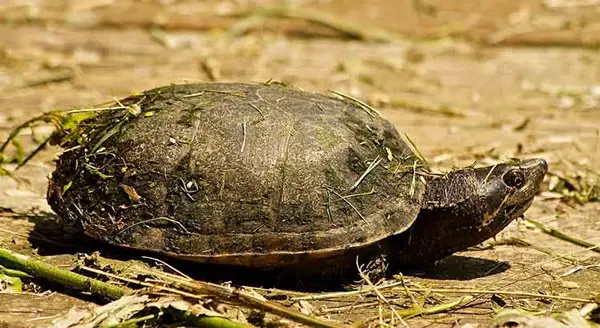
- Scientific name: Sternotherus odoratus
- Common name: Common Musk Turtle, Eastern Musk Turtle, Musk Turtle, Stinkpot
- Family: Kinosternidae
- Size: 2 to 4.5 inches
- Lifespan: 30 to 50 years
- Conservation status: Least Concern
The Common Musk Turtle is another aquatic turtle found in New York’s slow-moving and sluggish streams as well as still water bodies. The turtle usually prefers areas with dark crevices, where it can easily hide. It also prefers lots of plant matter to burrow in and hide.
An average adult eastern musk turtle is quite small (2 to 4.5 inches long). It has a pretty plain appearance with highly consistent colors. Both the shell and skin usually share the same color and can range from dark brown to black.
The turtle shell has one unique feature—a ridge traversing its entire shell length. Besides, it has another distinctive feature: two light-colored stripes on its head.
Common musk turtles of New York are herbivorous and will eat small aquatic or semi-aquatic animals, carrion, and aquatic vegetation. They will also feed on any other vegetation on land.
When it feels threatened, this musk turtle species emits a foul odor (a musky odor, hence its name). This scent can be detected in water or on land. It can also easily waft through the air to its predators.
Also, these New York turtles are good at climbing trees! This great capability enables them to go high up tree branches to find a safe resting place and avoid predators.
9. Spotted Turtle
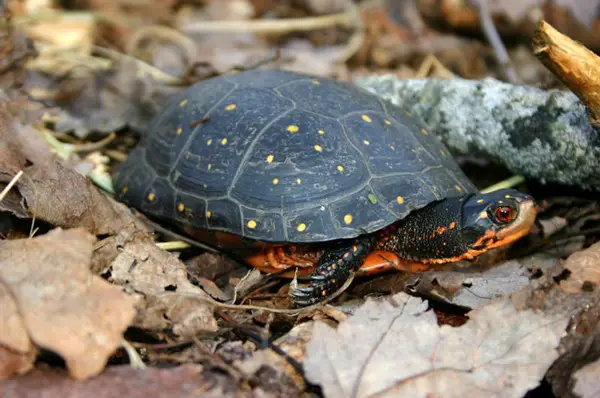
- Scientific name: Clemmys guttata
- Common name: Spotted Turtle
- Family: Emydidae
- Size: 4 to 5 inches
- Lifespan: 25 to 50 years
- Conservation status: Endangered
The spotted turtle is fairly widespread across the state of New York. It is mainly concentrated around the western counties bordering Lake Ontario. It is also found in southeastern areas, including Long Island and New York City.
Spotted turtles in New York reside in shallow marshes, swamps, and bogs. They’re semi-aquatic and are comfortable on the land just as they are in the waters.
An adult spotted turtle has a smooth upper shell that ranges from olive to dark brown in color, with some light yellow spots. The neck and head feature irregular orange or yellow spots and streaks. Also, their tails are fairly long.
The turtles are omnivorous and their diet involves crustaceans, mollusks, insects, and plant matter (occasionally). Note that these turtles are aggressive hunters and will actively seek their prey.
Unfortunately, the population of spotted turtles in New York is on the decline due to human interference and habitat loss. Their unique shell patterns make them a favorite species of a pet turtle for many people.
For this reason, they’re listed as endangered and protected by many governing bodies. In New York state, you can only own ONE spotted turtle and not more than that!
Above all, the spotted turtles of New York are incredibly smart. Studies carried on them using a maze indicate they have the same brain capacity as the mouse!
Also read: Turtles in Oregon
10. Wood Turtle
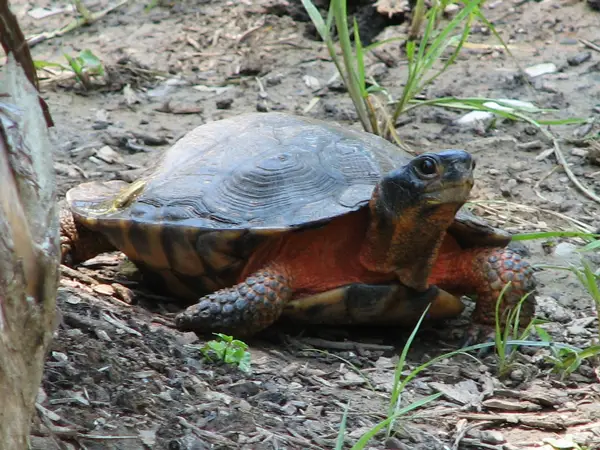
- Scientific name: Glyptemys insculpta
- Common name: Wood turtle, Sculptured Tortoise, Redleg, Red-legged Tortoise
- Family: Emydidae
- Size: 5.5 to 8 inches
- Lifespan: 40 to 60 years
- Conservation status: Endangered
Wood turtle species also inhabit the various woodland habitats across New York state. However, they also tend to stay near the water and will frequently venture into it.
During winter, they tend to hibernate at the bottom of deep rivers and pools.
The turtles get their name from their sculpted-like looks. Their upper shells are dark brown and have sport patterns resembling wood grain and growth rings.
Their scutes may sometimes appear like they’re pyramiding, further enhancing their sculpted shape.
Wood turtles of New York are diurnal omnivores and their diet mainly consists of berries, plants, insects, and mollusks.
They forage for their food widely and have even been observed stomping their feet on the ground as a way of tricking the earthworms into surfacing.
11. Blanding’s Turtle
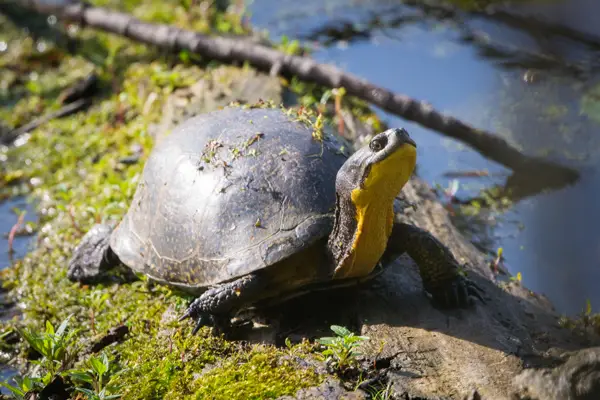
- Scientific name: Emydoidea blandingii
- Common name: Blanding’s Turtle
- Family: Emydidae
- Size: 5 to 8 inches
- Lifespan: up to 80 years (or more!)
- Conservation status: Endangered
Blanding’s Turtle is also known as the “turtle that smiles” and is named in honor of William Blanding, the American naturalist. It is mainly concentrated in the northern counties of New York.
The species is semi-aquatic and is categorized as endangered species in New York. It is mainly concentrated in the northern half of this state, but its population is quite scattered—making it hard to find.
Blanding’s turtle has a dark oval shell covered with faint yellow speckles. The lower side of its shell is usually yellow with black patches.
Blanding’s turtle in New York prefers living in marshy habitats. And the fact that it’s losing these favorite habitats is one of the reasons causing its population to decline fast.
Because this turtle species is omnivorous, it feeds on leatherworks, crayfish, and aquatic invertebrates. It also occasionally feeds on plants and doesn’t rely on water to help it sallow its food as it’s the case with most turtle species.
12. Bog Turtle
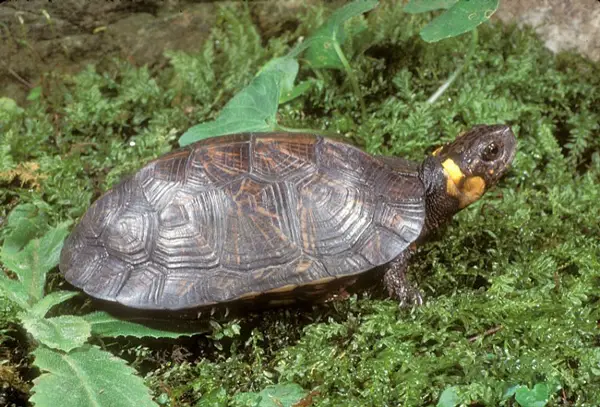
- Scientific name: Glyptemys muhlenbergii
- Common name: Bog Turtle, Muhlenberg’s turtle
- Family: Emydidae
- Size: 3.5 to 5 inches
- Lifespan: up to 40 years
- Conservation status: Critically Endangered
The Bog turtle is the smallest aquatic turtle you’ll find in New York and in North America. In New York, they’re centered in southern as well as a few central counties.
The species is critically endangered and is one of the rarest turtles in the state; it is only seen in the western counties of New York.
Mind you; selling or owning a bog turtle in New York is illegal!
An adult bog turtle’s carapace coloration ranges from black to olive or dark brown and features a central keel ridge. Some of the scutes making up their upper shell may also bear red or yellow-star markings. And their heads have distinctive orange or yellow patches.
The bog turtle is known to inhabit wetland areas such as marshes or bogs populated with grass cover.
These turtle species are diurnal omnivores and like eating insects, mollusks, and occasional vegetation. They’re most active during warm parts of the day.
13. Red-eared Slider
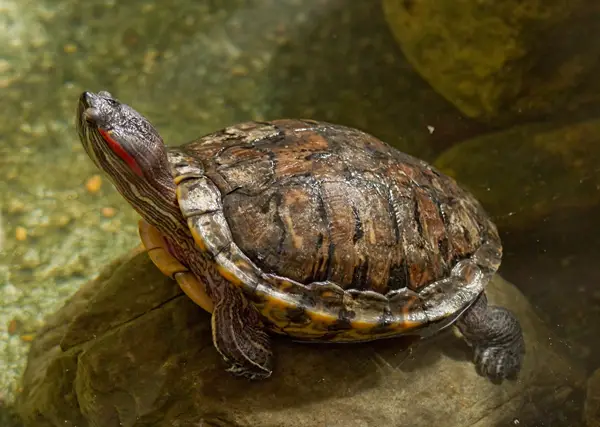
- Scientific name: Trachemys scripta
- Common name: Red-eared Slider, Red-eared Terrapin
- Family: Emydidae
- Size: 7 to 11 inches
- Lifespan: 30 to 40 years
- Conservation status: Least Concern
The red-eared slider is a sub-species of pond sliders and a non-native species of New York. It is found in New York as a result of the pet trade and pet releases by pet owners.
Mind you, these turtles have become an infestation at ponds at Central Park and other outdoor spaces in NYC. And they can easily overpower the native turtles of the state of New York.
Red-eared slider turtle is semi-aquatic and prefers living in marshes, ponds, lakes, and creeks.
It gets its name from the small red stripe surrounding its ears (or behind the eye), and its ability to quickly slide off logs and rocks into the water.
Generally, the skin and shell coloration of this slider can be brown or black, with yellow stripes covering the skin.
The red-eared sliders of New York are pretty large and the adults reach 7-12 in length (though females are generally larger than males).
These New York pond sliders are omnivorous and like eating fish, snails, insects, and aquatic vegetation. They also eat land vegetation, including fruits and vegetables.
14. Yellow-bellied Slider
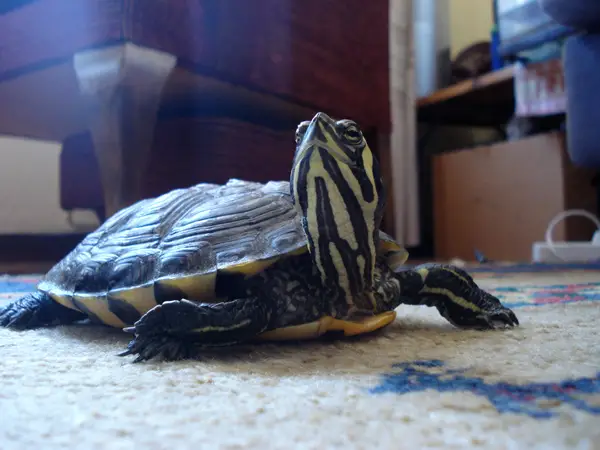
- Scientific name: Trachemys scripta scripta
- Common name: Yellow-bellied slider
- Family: Emydidae
- Size: 8 to 13 inches (females), 5 to 9 inches (males)
- Lifespan: 30 to 40 years
- Conservation status: Least Concern
The yellow-bellied slider turtle is a sub-species of pond sliders and another non-native species of New York. The turtle is unregulated and is found in NY as a result of pet releases by pet owners.
The latest sightings of this turtle in New York include Long Island and New York City.
Yellow-bellied turtle is semi-aquatic and lives in water as well as land. And it can be found in a variety of habitats including floodplain swamps slow-moving rivers, seasonal wetlands, marshes, and even permanent ponds.
As the name suggests, this turtle features a yellowish plastron. Plus, it bears yellowish markings on its skin, not to forget prominent yellow stripes behind its eyes. The upper shell color ranges from dark brown to olive.
These New York sliders are omnivorous and like eating fish, snails, insects, and aquatic vegetation. they also eat land vegetation, including fruits and vegetables.
It is also worth noting that New York Yellow-bellied sliders are a popular choice of pet turtles for most folks. They don’t require a lot of special care, which makes them a favorite for many folks.
15. Eastern Box Turtle
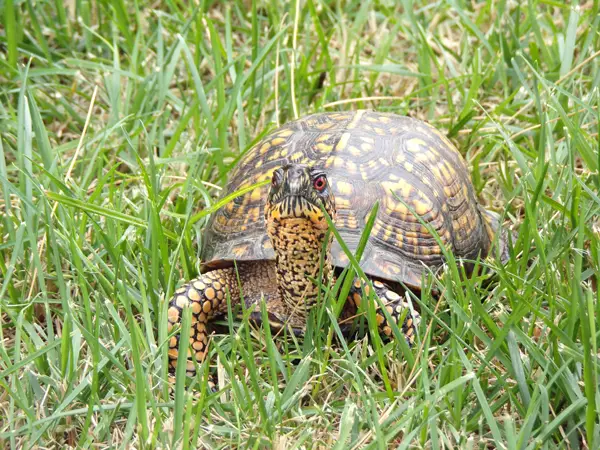
- Scientific name: Terrapene carolina carolina
- Common name: Common Box Turtle, Land turtle
- Family: Emydidae
- Size: 4.5 and 7 inches
- Lifespan: 50 to 100 years
- Conservation status: Vulnerable
The eastern box turtles of New York are found in the state’s southern and southwestern regions. They prefer living in dense thickets and woodland areas. These areas offer them abundant access to sunlight and food sources nearby.
An adult turtle of this species is about 4.5 to 7 inches and weighs just 2lbs. It has a high, domed shell shape with a ridge running from head to toe. The shell of this turtle has varying colors of olive, brown, and tan.
The variation in markings on the shells of these turtles is so variable that you can’t easily recognize one by looking at the shell alone.
These eastern box turtles of New York are omnivorous and feed on a variety of foods including insects, meat, fruits, vegetables, and various types of vegetation.
Note that eastern box turtles are taken from the New York wild for pet trade, leading to a decline in their population. For this reason, many states have illegalized capturing and selling of this species.
And those in captivity end up dying due to poor conditions or being abandoned or released back into the wild because they’re too demanding to maintain.
16. Green Sea Turtle
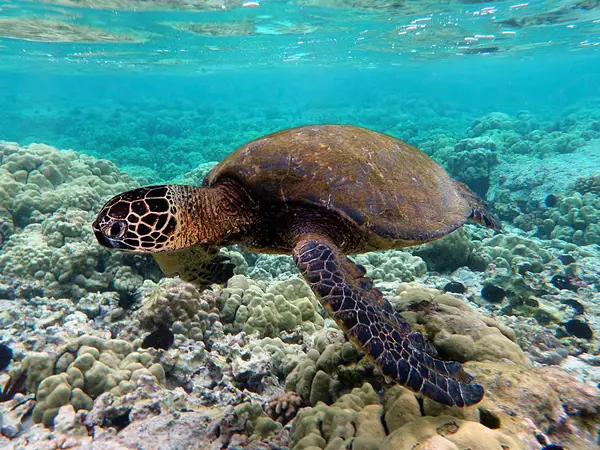
- Scientific name: Chelonia mydas
- Common name: Green turtle, Pacific green turtle, Black sea turtle
- Family: Cheloniidae
- Size: 2 to 5 feet
- Lifespan: 60 to 70 years
- Conservation status: Endangered
The green sea turtle species is classified among the largest hard-shelled sea turtles in New York. It can reach up to 4 feet in length and weighs up to 400lbs.
This species is characterized by scutes that run down the middle; they’re 4 on each side. The shell color can be gray, dark brown, or olive with a yellow-to-white bottom shell or plastron.
It also features a serrated beak on its lower jaw and two large scales resign between the eyes.
Males are generally larger than females and have longer tails. The females lay their eggs on the beach and use their paddle-shaped flippers to easily burrow in the sand when laying eggs. A single green turtle can lay up to 200 eggs!
This New York sea turtle species gets its name from its primary diet which consists of age and seagrasses (mind you, this diet is responsible for tinting its cartilage green).
Green turtles in New York are usually found in tropical as well as subtropical waters throughout the years. They live in coastal lagoons and bays in New York.
They also tend to migrate to cooler temperatures and even boreal waters when the weather gets warmer.
17. Hawksbill Sea Turtle
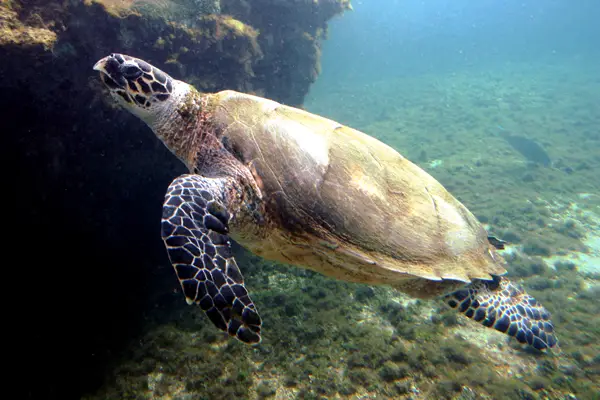
- Scientific name: Eretmochelys imbricata
- Common name: hawksbill turtle
- Family: Cheloniidae
- Size: 2.5 to 3 feet
- Lifespan: 50 to 60 years
- Conservation status: Critically endangered
Hawkbill turtles are generally found in tropical oceans in New York. While they live in the open ocean, they tend to spend more time in coral reefs and shallow lagoons in New York.
The adult has an average size of 3 feet and weighs around 180 pounds.
The shell of this turtle features amber upper shell with irregular light and dark streaks. They also feature predominant black and molten-brown easily radiating to the sides.
The shell tends to change color depending on the water temperatures.
This colored and patterned shell makes this turtle highly valuable and is commonly sold as “tortoiseshell” in the markets.
The hawkbill turtle is so named due to its narrow, pointed beak. It also has a distinctive pattern of overlapping scales on its shells which form a serrated look on the edges.
These turtles mainly feed on the sponge which they easily extract from reef crevices with the help of their narrow, pointed beaks. They also feed on jellyfish.
During nesting, a female hawkbill turtle will look for small coves, “pocket” beaches, or inlets surrounded by rocks. They tend to travel high up the beach to lay eggs in shelters formed by the plants.
18. Kemp’s Ridley Sea Turtle
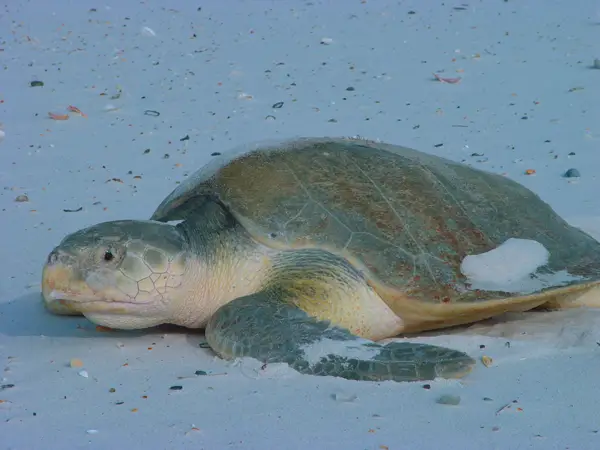
- Scientific name: Lepidochelys kempi
- Common name: Atlantic ridley sea turtle,
- Family: Cheloniidae
- Size: 2+ feet
- Lifespan: 30+ years
- Conservation status: Critically endangered
Kemp’s ridley sea turtle is the smallest species of all the sea turtles in New York. They’re found on muddy or sandy coastlines with shallow waters.
This turtle is the rarest sea turtle species and is one of the world’s most endangered species.
The average adult size is about 2 feet and weighs approx. 110 lbs. They have adapted flippers (front limbs) and a beak.
The species is called Kemp’s ridley because Richard Moore Kemp of Key West was the first to send its specimen to Samuel Garman at Harvard university. However, the origin of the name ridley is still unclear.
Note that these turtles tend to change their color as they age. Baby turtles feature dark purple color along the sides which turns into yellow-green as they mature.
Kemp Ridley is also the only sea turtle that nests during the day. These New York turtles also practice Arribada nesting, which involves all the females nesting together in a tight group.
This helps them protect themselves better from predators as well as help their hatchlings easily make it to the open ocean.
19. Leatherback Turtle
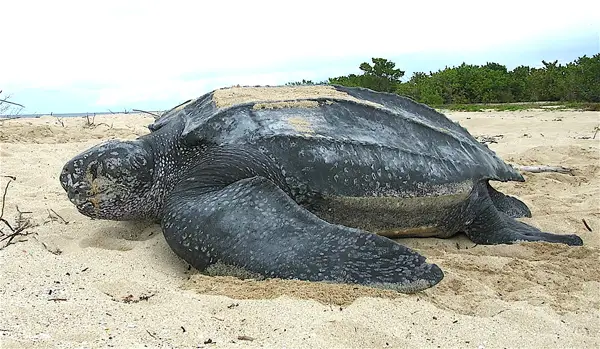
- Scientific name: Dermochelys coriacea
- Common name: leathery turtle, trunk turtle, Lute turtle, luth
- Family: Dermochelyidae
- Size: 5 to 6 feet
- Lifespan: 50+ years
- Conservation status: Vulnerable
The leatherback sea turtles are found in New York state and are known to grow to mammoth sizes (up to 6 feet!). An average adult can also weigh as heavy as 540lbs (or heavier!).
Leatherback turtles usually have black shells. And they differ from other species of turtles with their smooth leathery carapace and skin. Their upper shell is made up of a flexible layer of dermal bones covered by tough and oily connective tissue and smooth skin.
The body of this turtle is barrel-shaped and then tapered to the rear. They have a total of 7 longitudinal dorsal ridges and their whole body is almost completely black, with some variable spotting.
Leatherback turtles in New York have tooth-like cusps that work closely with their sharp-edged jaws to enable them to easily feed on jellyfish, salps, and other gelatinous zooplankton.
As for the habitat, these turtles of New York are fond of tropical and subtropical waters all year round. But they tend to migrate to cooler, temperate, and boreal waters during warm weather.
Note that this species is highly migratory and can swim as many as 10,000 miles in a year between foraging and nesting grounds. They’re also excellent divers—with the deepest diving record standing at whopping 4,000 feet!
20. Loggerhead Sea Turtle
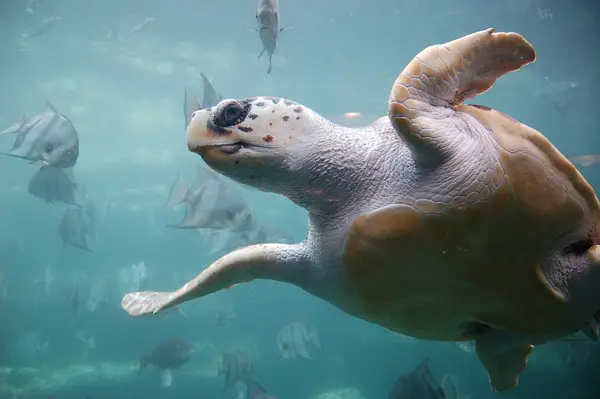
- Scientific name: Caretta caretta
- Common name: Loggerhead, Loggerhead Sea-Turtle
- Family: Cheloniidae
- Size: 3.5 feet
- Lifespan: 70+ years
- Conservation status: Endangered
Loggerhead sea turtles boast their place as the most abundant sea turtle species in the United States and are found in many states, including New York.
These turtles are pretty big and can reach up to 3.5ft in length. They weigh up to 350 pounds and can live for a whopping 70 years or more.
A loggerhead is distinguished by a slightly heart-shaped carapace that’s reddish brown in color, with pale yellow plastron. Some species also feature yellow-bordered scutes.
This turtle species of New York gets its name from its large head. It has powerful jaws that enable it to feed on a variety of foods including conch, whelks, insects, jellyfish, gastropods, and algae.
The loggerhead turtles in New York are usually found in coastal regions, especially in shallow bays. They prefer living in temperate, tropical, and subtropical waters all year round. However, they also tend to migrate to sandy ocean beaches during nesting time.
Related: Turtles in Ohio
Conclusion
Now you know the 20 turtle species inhabiting New York, the Empire State. The native species of NY are 12 in total and include the common snapping turtle (regarded as the state’s official reptile), and terrestrial eastern box turtles.
Other natives include spotted turtles, bog turtles, painted turtles, and wood turtles.
Non-native turtles are also found in the New York state and include the pond sliders (red-eared and yellow-bellied slider) as well as northern red-bellied Cooter.
Not to forget, 5 sea turtles can also be spotted on the coast of New York, including the Green sea and the Kemp Ridley sea turtles.
